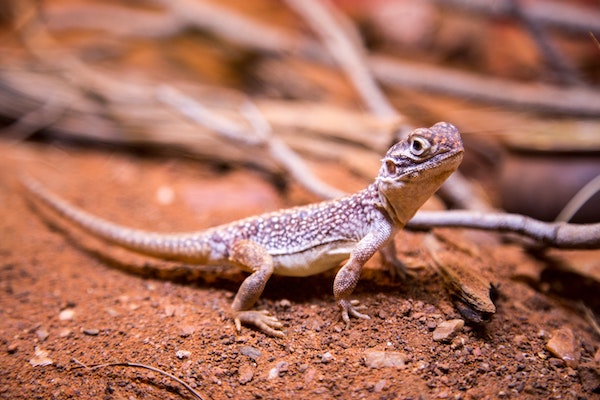One of the most important parts of reptile care is creating an enclosure that will keep them comfortable and feeling at home. However, reptile keeping can be expensive. A large vivarium can cost upwards of $300, and PVC enclosures can cost even more. For this reason, many pet owners choose to build their own DIY reptile enclosures. While this may be more cost-effective, it can be labor-intensive and require several tools like saws, tape measures, hammers, clamps, and drills.
DIY Reptile Enclosure Sizing
Reptile enclosures can be made out of many things depending on the size that you need. Some larger reptiles require enclosures as large as 8×8 feet, though for most a 6×4 feet space is enough. There are many options for the base for your enclosure, including old bookcases, an entertainment center, old windows, wardrobes, unused cabinets, extra plywood, or even display cases. If you’re thinking of creating an outdoor enclosure, wire mesh or chicken wire is an excellent material to use.
Once you have the right size space for your scaly friend then you can start to build. If you’re using a recycled piece of furniture like a bookcase, cabinet, wardrobe, or even extra plywood, seal the wood with a reptile-safe sealant since many reptiles need a humid environment and you don’t want the wood to rot. If your friend prefers the ground instead of climbing, you can simply turn the bookcase or wardrobe on its side.
Openings
While you may want a separate opening on the top, some reptile lovers prefer to have the viewing window be the opening. Make these viewing windows out of old windows or plexiglass and secure them with clasps and hinges. If you want to get fancy, you can install a track where the cupboard or wardrobe doors used to be to create a sliding door for easy access.
If you have old windows and want to create more of a terrarium than a box, you can use a safe sealant to glue the windows together into the shape and size you want. However, making a DIY reptile enclosure completely airtight will suffocate your pet. Efforts will have to be taken with any enclosure, no matter what material is used, to create proper ventilation.
Temperature & Humidity
Many reptiles are tropical and need a temperature-regulated enclosure. Installing and wiring a heat lamp inside of your DIY reptile enclosure is one of the easiest ways to do this. If you’re not much of an electrician or don’t want to bother drilling holes, consider using recycled wire mesh on top of your enclosure with a heat lamp above it, allowing your reptile to stay warm.
Some tropical reptiles come from more humid climates and thus need their own artificially humid environment. If this is the case, installing an automatic mister and/or using a water-absorbent substrate will help. Using solid materials for your enclosure, like plexiglass or plywood, will also help to maintain humidity.
Hiding & Basking Spots
There are many reptiles, especially snakes, who prefer to remain hidden inside their enclosure. Without a hiding place, they can become stressed and their health will decline. However, you don’t need anything fancy from the pet store. Some people simply cut an opening in a recycled plastic container and flip it upside down. However, you may want to build your own hides or basking spots directly into the enclosure. This can be done with extra material or an instant spray foam. Instant spray foam can then be carved and painted to look like rocks to make the enclosure look more natural. Remember to seal any spray foam that you use.
Related Content: DIY Cat Toys from Recyclable Materials
Feeding
Lastly, feeding a reptile can be pricey. Whether you have a snake that only needs to be fed twice a month, or a bearded dragon that needs to be fed daily, the upkeep of a reptile is a lot of work. If you aren’t interested in returning to a pet store regularly, some insects, like crickets, can be kept and bred in colonies. This can create a solid supply of food for your reptile and will save you frequent trips to the store. Some lizards also eat fruits and vegetables, which you can grow yourself, or you can give them your personal leftover scraps. As always, make sure to research the proper nutritional requirements for your reptile.
(If your reptile eats rodents like mice or rats, try to feed them frozen thawed if possible. Feeding on live animals can result in serious injury to your reptile and undue stress to the prey. NEVER capture a live mouse from the wild to feed to your reptile as it can contain parasites or viruses. If you suspect your reptile has a parasite, take them to a vet immediately.)
Words of Caution
While the hard work and effort of creating your own DIY reptile enclosure may be appealing, you also must be very careful. Reptiles are extremely sensitive, and many come from climates that don’t match yours. Be sure to research reptile-safe paints, foams, glues, sealants, and more to keep your reptile from harm. If you’re using wood to create an enclosure, be aware that wood will rot over time, especially with exposure to humidity.
We understand your desire to create a natural environment by using real soil and plants. However, DO NOT take plants or soil from outside. They can contain insects, bacteria, or toxic chemicals that will harm your pet. Research plants safe for your specific reptile and buy them at an experienced pet store. Unfortunately, you can’t work around this as there are many toxic plants and insects that can harm your reptilian friend. Research the proper substrate to use for your reptile and make sure to get it at a reputable pet store. Even bagged and sealed substrates can contain mites or flies, so baking the substrate in an oven or putting it in the freezer for a few days before use may be required.

